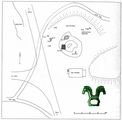Pillerhöhe
| Field name | |
|---|---|
| Site: | Fliess [from first object] |
| Coordinates: | 47° 7' 8.40" N, 10° 40' 1.20" E [from first object] |
| Objects found here: |
|
Map
Commentary
The Pillerhöhe is the transition point of the connection between the Upper Inn valley near Prutz and Fliess and the Pitz valley, which forms a more direct connection to Imst in the Inn valley that the course of the Inn via Landeck; this old road is known as Alter Weg (see image below). The archaeological site is situated on the crest of a plateau, at an altitude of 1560 m a.s.l., close to a high, steep drop which is clearly visible from afar. (Tschurtschenthaler & Wein 1998: 227; Tschurtschenthaler & Wein 2002: 637–639)
On 6 May 1992, the laymen Kassian Erhart and Franz Neururer reported the discovery of about 70 objects on the Pillerhöhe to the Institute of Classical Archaeology of the University of Innsbruck. After a survey, excavations were started immediately. Since then, annual excavations are undertaken by the University of Innsbruck. (Tschurtschenthaler & Wein 1998: 227; Tschurtschenthaler & Wein 2002: 636f.)
|
site plan of the sanctuary on the Pillerhöhe
|
The site is a sanctuary, which was used over a long period of time. The finds indicate its active use from the Middle Bronze Age to Late Antiquity and even to the Early Middle Ages (Tschurtschenthaler & Wein 1998: 234–240). Judging by the types of finds, the sanctuary was used by men as well as by women (Tschurtschenthaler & Wein 2002: 665). During an initial period, the offerings were primarily sacrifices of animals or vegetables. Around the turn from the Hallstatt to the La Tène period, more object sacrifices begin to appear, to become exclusive in the 4th to 3rd and the 1st centuries BC (Tschurtschenthaler & Wein 2002: 652–664). From the 1st century BC onwards, offerings in monetary form are made as well (details in Tschurtschenthaler & Wein 2002: 639–652). The object sacrifices comprise items from all areas of daily life: jewellery, components of attire, weapons, tools, and pottery. Moreover, there are objects which were produced exclusively for the sacrifice, such as the anthropomorphic bronze plaques (cf. Tschurtschenthaler & Wein 2002: 657–661, fig. 10) and symbolic pars pro toto weapon sacrifices in form of bronze plaques which imitate shields (cf. IT-9 fragment).
The sanctuary can be divided into two large areas (Tschurtschenthaler & Wein 1998: 230–234; Tschurtschenthaler & Wein 2002: 638): the more norherly area of the fairground (Festwiese) and the area of the altar where the burnt offerings took place. The image above shows stone piles (SA1, SA2) and fireplaces (F1–8). The fairground was the site of the ritual banquet performed by the participants of the offering, and also the place where sacrificed objects were deposited (Tschurtschenthaler & Wein 1998: 231). That the deposition of objects was independent of the burning at the altar is indicated by the fact that these objects do not have burn marks (Tschurtschenthaler & Wein 2002: 665).
The handle of a Henkelbecher IT-8 potsherd as well as two bowls with script-like marks (EX-114, EX-115; see Non-script notational systems) were discovered in the area of the fairground. The exact find spot of the miniature shield fragment IT-9 fragment will become known when the relevant material is published archaeologically.
Find spots from the environs of the Pillerhöhe which have not yielded any inscribed objects include the hoard from Fliess which dates to the Hallstatt period (cf. the marks on bronze axes kept at Archäologisches Museum Fliess mentioned here; see also Sydow 1995), the weapon deposits from the Piller and from Wenns, as well as the remains of a prehistoric settlement somewhat to the south of the sanctuary site. All these find spots are located near and must be associated with the Alter Weg from Prutz/Fliess to Imst (Tschurtschenthaler & Wein 2002: 639).
